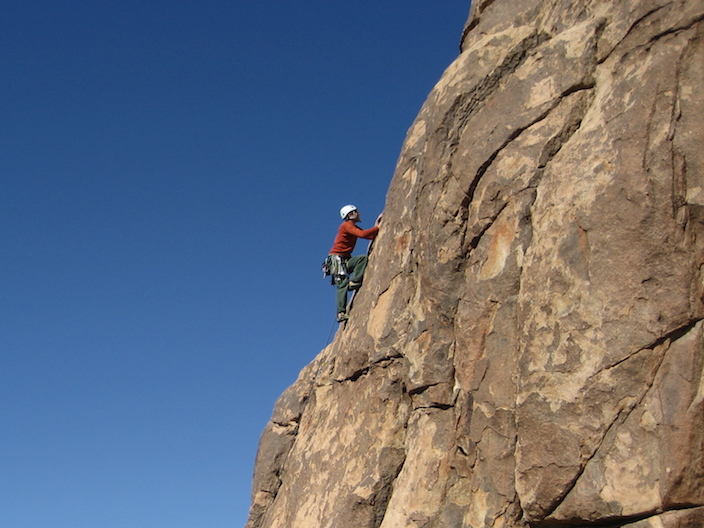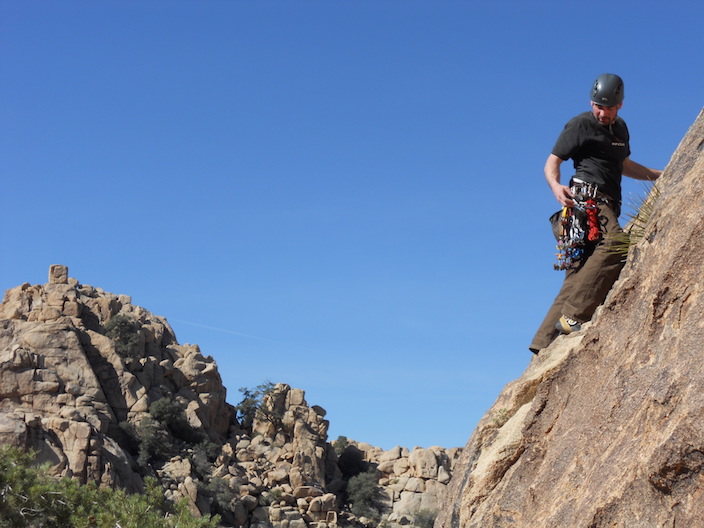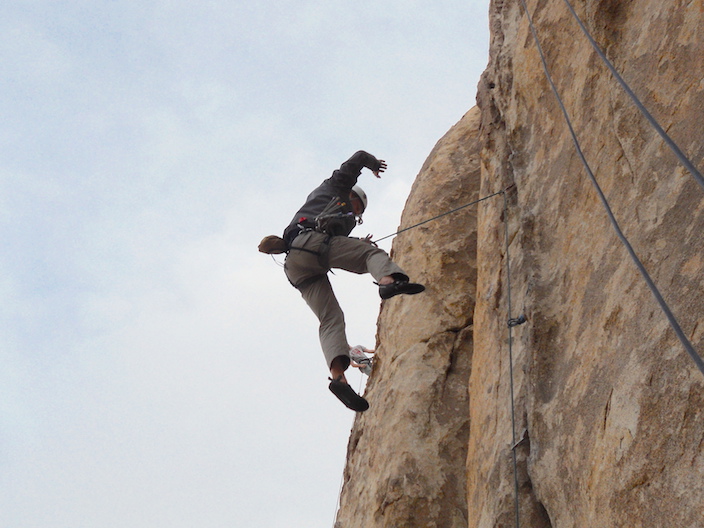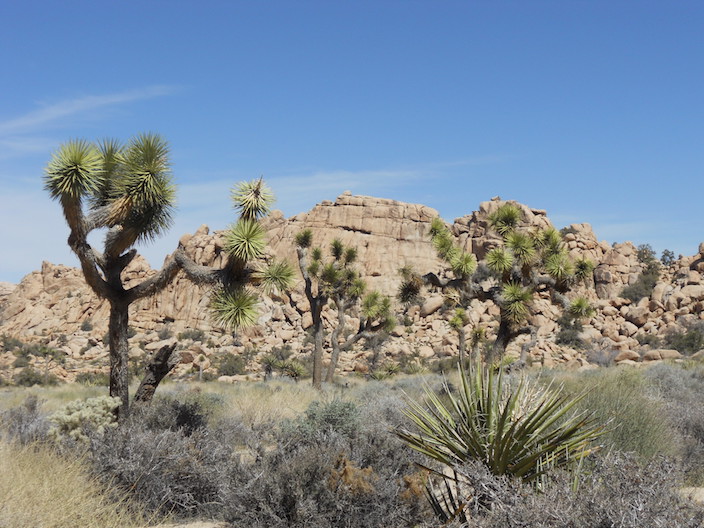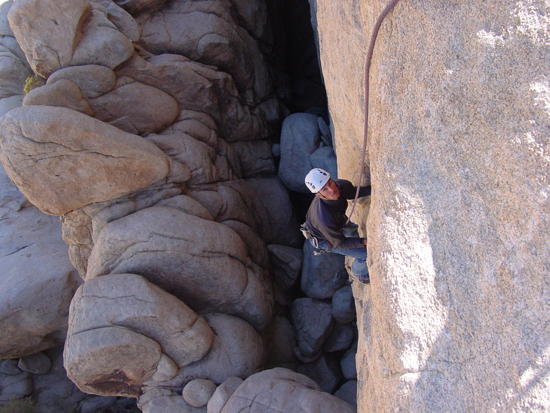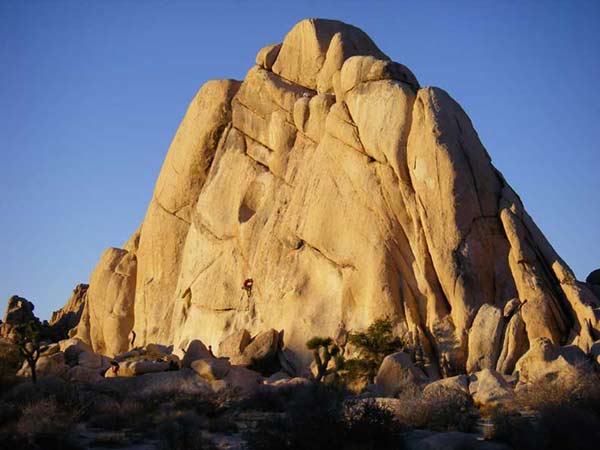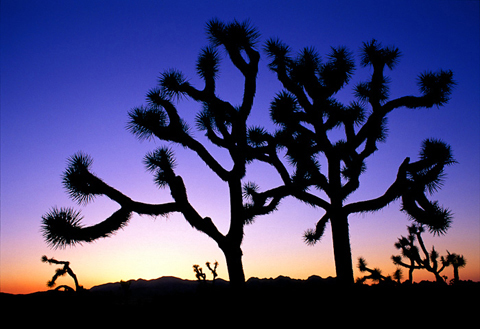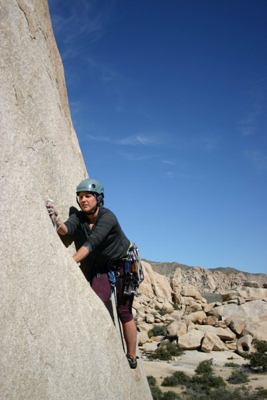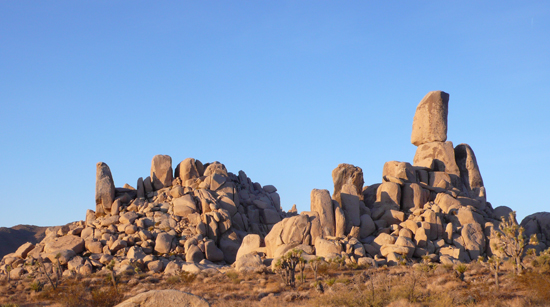Guided Rock Climbing at Joshua Tree, CA Overview Joshua Tree National Park is a classic winter retreat for rock climbers of all levels. The colors, the plant-life, the animals and the rock in this unique 4,000-foot plateau at the border between the high Mojave Desert and the Sonoran Desert of northern Mexico combine to create an absolutely breathtaking experience. The timeless desert beauty of Joshua Tree makes it a regular stop on the climbing road-trip circuit. The combination of the Southern California weather, a pleasant social scene and beautiful campgrounds, and the countless boulders, cliff-faces and rock outcroppings come together to make climbing at Joshua Tree one of the most sought-after climbing experiences in America.
A winter sunset in Joshua Tree. Troy Mayr troymayr.com
Climbing Highlights
Climbers are deeply engaged by the somewhat unusual rock that the area offers. A member of the granite family, the quartz monzonite that makes up most of the features in the area provides some of the highest quality of rock for climbing, with sharp edges, abundant cracks, and large crystals that give it a very high friction factor. Whether your interest is low-to-the-ground bouldering or multi-pitch lead climbing, the abundance of rock throughout the park is overwhelming, and not surprisingly, many lines remain unclimbed.
For beginners , Joshua Tree might well be the friendliest winter venue in North America. The small scale, climbing variety, and relative absence of underbrush make J-Tree a perfect outdoor classroom. Many of the minor summits are accessible easily by scrambling, making for no-hassle top-roping and bouldering.
For experienced climbers who are looking to advance their skills, Joshua Tree offers nearly infinite options. Perhaps most obviously, Joshua Tree is virtually an outdoor climbing gym for crack climbing , offering clean, parallel-sided or flaring cracks in every possible width, angle, and shape. Climbers with home crags as diverse as the Gunks, Red Rock, and Rumney, where cracks are often uneven and do not demand impeccable crack technique, flock to J-Tree to hone their jamming and offwidth skills.For Bouldering , J-Tree is a dream, the perfect location to enjoy boulder problems of every description and to try out roped climbing.Aspiring trad leaders can take advantage of this area's great variety of cracks to learn protection placement and anchor building, and to practice lead climbing skills in a user-friendly setting.
The Scene
Yet for all the attraction of its rock, the biggest draw of Joshua Tree might be its pleasant climate and social scene. From October through May, Joshua Tree is both an off-season training ground for climbers and an almost spiritual haven for desert lovers of all stripes. Park campgrounds are nestled among wildly shaped boulders and formations, giving an otherworldly feel to the time spent here.
The park attracts both newbies and internationally recognized climbing personalities, weekend warriors and van-living adventurers taking a break between expeditions. Climbers mix easily, joining up in ad hoc groups for cragging during the day and then mingling by campfires as night falls, with festivity often lasting late into the evening. Occasional night climbing further adds to the spice.
Location
Located less than a three hour drive from Los Angeles, just over three hours from Las Vegas, and less than an hour from Palm Springs, Joshua Tree National Park is the perfect place to try rock climbing. A few days of group instruction or private climbing with a guide in Joshua Tree is a great mid-winter break from the snow and frigid winds found in most of the rest of the country.
Joshua Tree National Park at a Glance
Courses for those just learning to rock climb , rock climbing outdoors for the first time, and learning to lead trad
Private guided rock climbing available from October through May
Easy access from many major metropolitan areas throughout the Southwest
Absolutely beautiful camping available in Joshua Tree National Park campgrounds and private campgrounds outside the park.
Easy access from resorts, motels, and bed & breakfasts in Palm Springs, Twentynine Palms, and the town of Joshua Tree.
Guided Rock Climbing at Joshua Tree, CA Areas and Routes Hidden Valley Campground
A climber leading up Buissonier (5.8-). Katy Pfannenstein
Hidden Valley Campground is the hub of climbing in the Park. One can climb five-star problems out of their campground or walk a short few minutes to some of the areas most praised climbs. Attractions here include: Intersection rock, the Old Women, the Blob, and countless boulders.
Real Hidden Valley
Located across the street from the park hub of Intersection rock, the Hidden Valley proper, or Real Hidden Valley, holds a short 1+mile nature loop that features stellar classrooms and moderate lines. The popular Sentinel rock sits at the center of the valley dominating the view with its popular East face. Popular routes here include:
Fotehog (3 pitches, 5.6)
Western Saga (3 pitches, 5.9)
Illusion Dweller (2 pitches, 5.10a)
Sail Away (1 pitches, 5.8)
Lost Horse Valley
For those looking to climb some longer lines, one might consider the Lost horse valley for its abundant long single pitches, or the fabulous multi-pitch lines on its namesake wall. Here one can escape the road and climb in a beautiful desert venue with challenging and varied lines. Some favorites are:
Bird on a wire (3 pitches, 5,10a)
Dappled Mare (3 pitches, 5.8)
Imaginary Voyage (1 pitches, 5.10d)
Saddle Rocks
The largest features in the park, the Saddle Rocks are large, seemingly-un-fractured domes sitting upon the Northern flank of Ryan mountain. These domes offer proud slab and face lines up the tallest features in the park. Featuring exposed-belays and thin climbing these features test ones technique and mental fortitude. Route highlights include:
A Walk on the wild side (4 pitches, 5.8)
Right On (4 pitches, 5.7) (Caution, this route's consensus rating is a sandbag!)
Santa Cruz (2 pitches, 5.10)
Guided Rock Climbing at Joshua Tree, CA Courses and Prices Because we run so many rock courses and because we are so flexible about dates, we don't publish a course schedule. To register, simply call our office and discuss the dates that you want. If you want to climb with one or more other climbers, we will work to match you up with others who are at a similar level of experience.
As the fall temperatures and wet weather start to overtake the more temperate rock climbing areas in the U.S., rock climbers begin their annual migration to the desert southwest in search of the sunny skies and warm rock found there for most of the winter months. Our season in Joshua gets started at the beginning of October and continues through the Spring, well into May. The shortest days of the year (December) can be brisk, but there are plenty of sunny options for climbing throughout the park.
Rates listed are per person/per day.
Ratio Half Day Full Day
1:1
$425
$475
2:1
$245
$325
3:1
$190
$250
4:1
$175
$225
5:1
$155
$200
6:1
$135
$175
Other Courses and Programs Offered in Joshua Tree National Park: Guided Rock Climbing at Joshua Tree, CA Details Program Cost Inclusions and Exclusions Tuition for this program includes the guide fees and provision of all group technical climbing equipment - personal climbing equipment such as clothing, boots, personal climbing gear, sleeping bag, tent, etc. is not included, but is available for rent.
Excluded is transportation to and from the program's meeting location, as well as transportation during the program. As such, you and your course mates will be required to make transportation arrangements from the program's meeting location to the climbing areas and back for yourselves and your guide, whether by renting a car or driving your own car. Lodging costs, all meals and food, excess baggage charges, fees for changing air itineraries because of delayed return from the mountains, personal health, baggage, and trip cancellation insurance, park entrance fees, and gratuities to guides are not included.
Approximate Distances to Joshua Tree National Park Los Angeles: 160 miles
Geology of Joshua Tree Joshua Tree offers great bouldering as well as countless single-pitch climbs and a number of quality multi-pitch routes. Glen Young
The quartz monzonite of Joshua Tree is a light colored and rough granitic rock. The rock formations in Joshua Tree tend to be dome-shaped and surrounded by flat desert plains. Approximately 100 million years ago these rocks were heated underground by the continuous movement of the Earth's crust. As the molten liquid oozed upward from deep below the surface, it slowly began to cool in a process that created large crystal grains. After the uplift, the erosive forces of wind and water did their work, which eventually exposed these rocks and isolated islands in the desert landscape. Fortunately for climbers, these granitic features make for a high friction playground with steep, impossible looking face climbs that are actually quite easy. Climbers will also find that most of the cracks in Joshua Tree National Park are shallow and flaring, but offer good placements for those at a beginner level and those that are seasoned level lead climbers.
Guided Rock Climbing at Joshua Tree, CA Related Courses
Program Finder
By Location
United States - Alaska
United States - Washington
United States - California
United States - Nevada
United States - Colorado
United States - Utah
Canada - British Columbia
South America - Argentina
South America - Bolivia
South America - Ecuador
South America - Patagonia
South America - Peru
Europe - Alps and Caucasus
Asia - Nepal and Tibet
Asia - Laos, Thailand, & Vietnam
Asia - China
Asia - Japan
Africa - Tanzania
Pacific and Antarctica
By Program Type
Instructional Courses
Group Summit Climbs
Expeditions
Skills Expeditions
Private Guided Programs
Treks, Tours, & Backpacking
Corporate Outings & Services
Government & Military
By Activity
Rock Climbing
Ice Climbing
Alpine Climbing
High-Altitude Climbing
Trekking and Backpacking
Skiing & Snowboarding
Guide Training & Rescue
Avalanche Training
Departure Month
July
August
September
October
November
December
Difficulty Level
Beginner
Moderate
Intermediate
Advanced
Very Advanced
x
